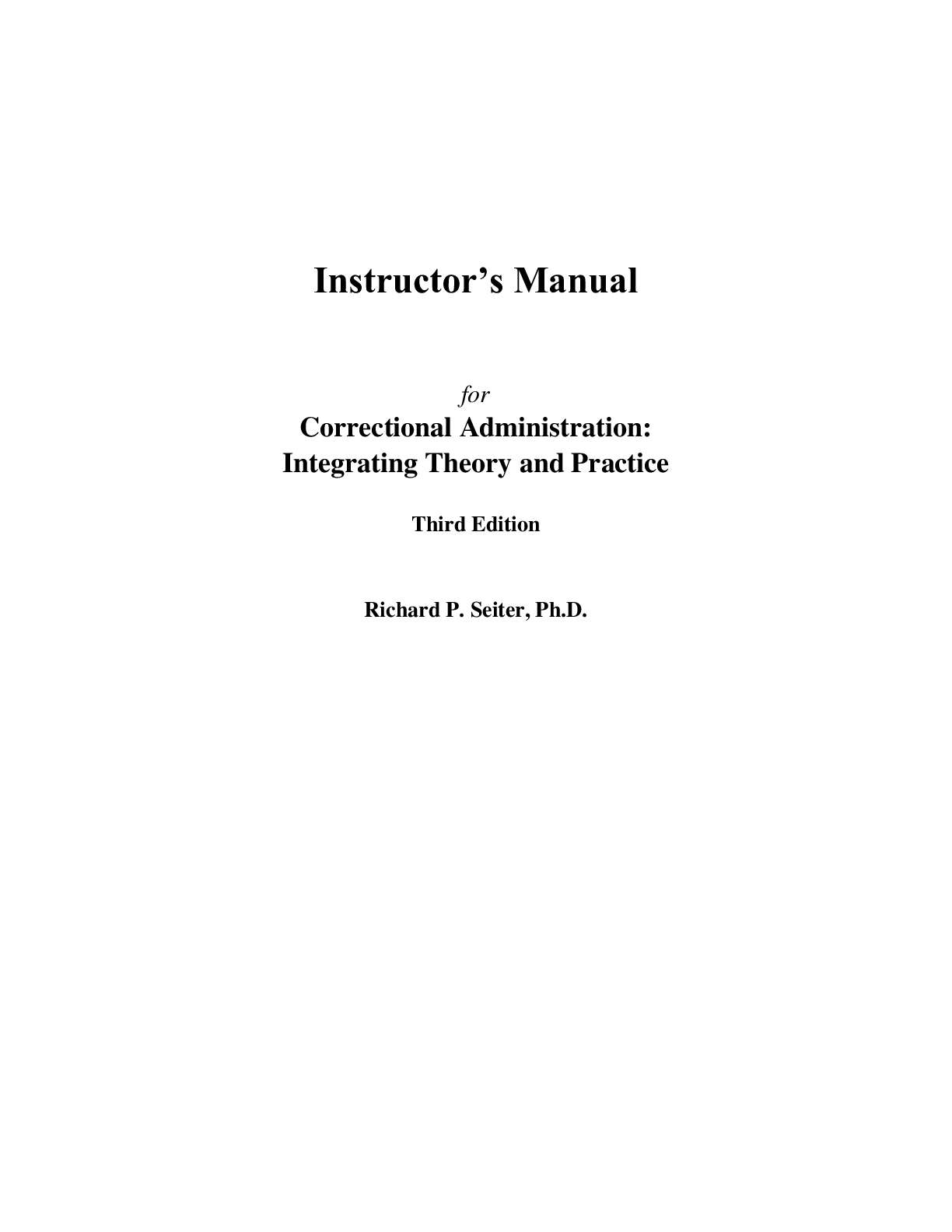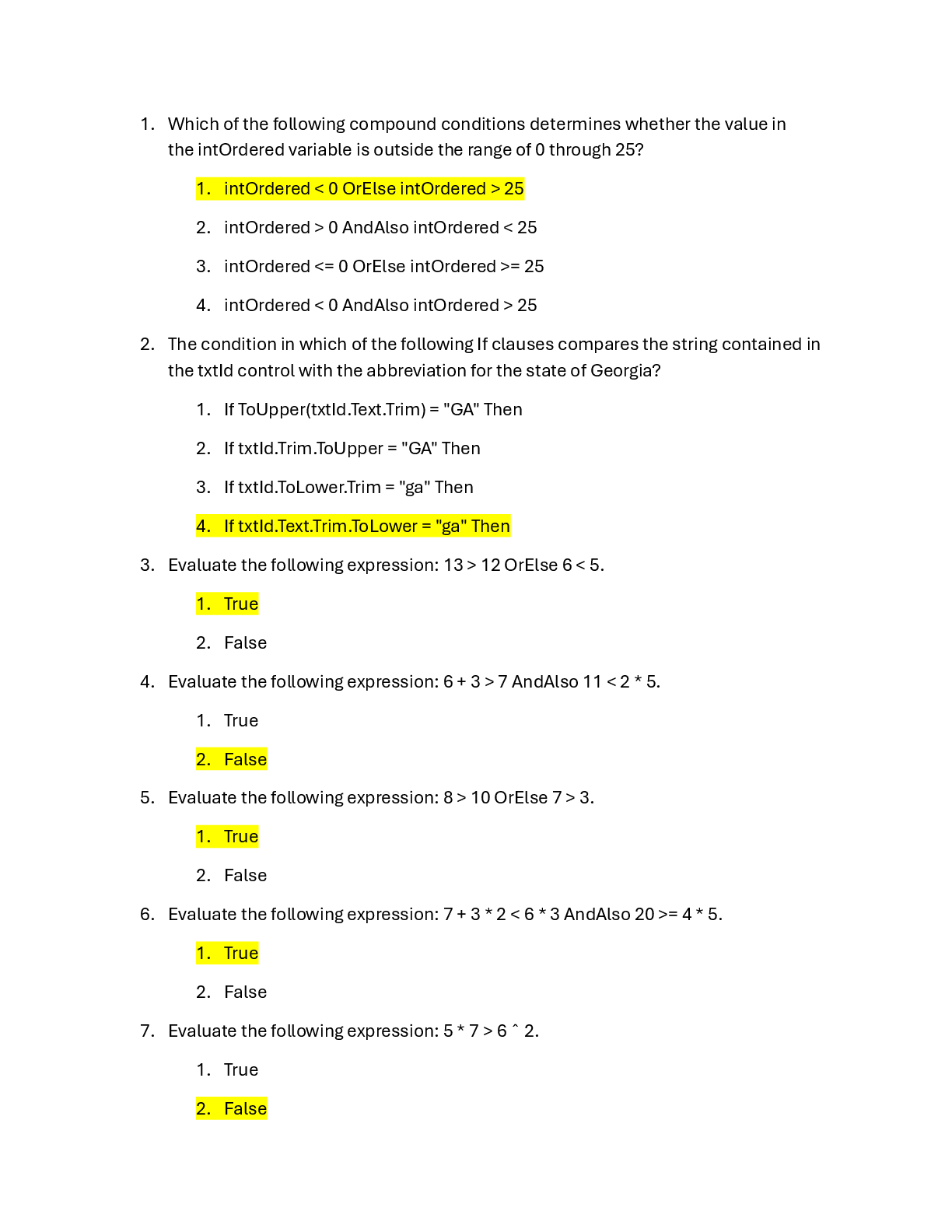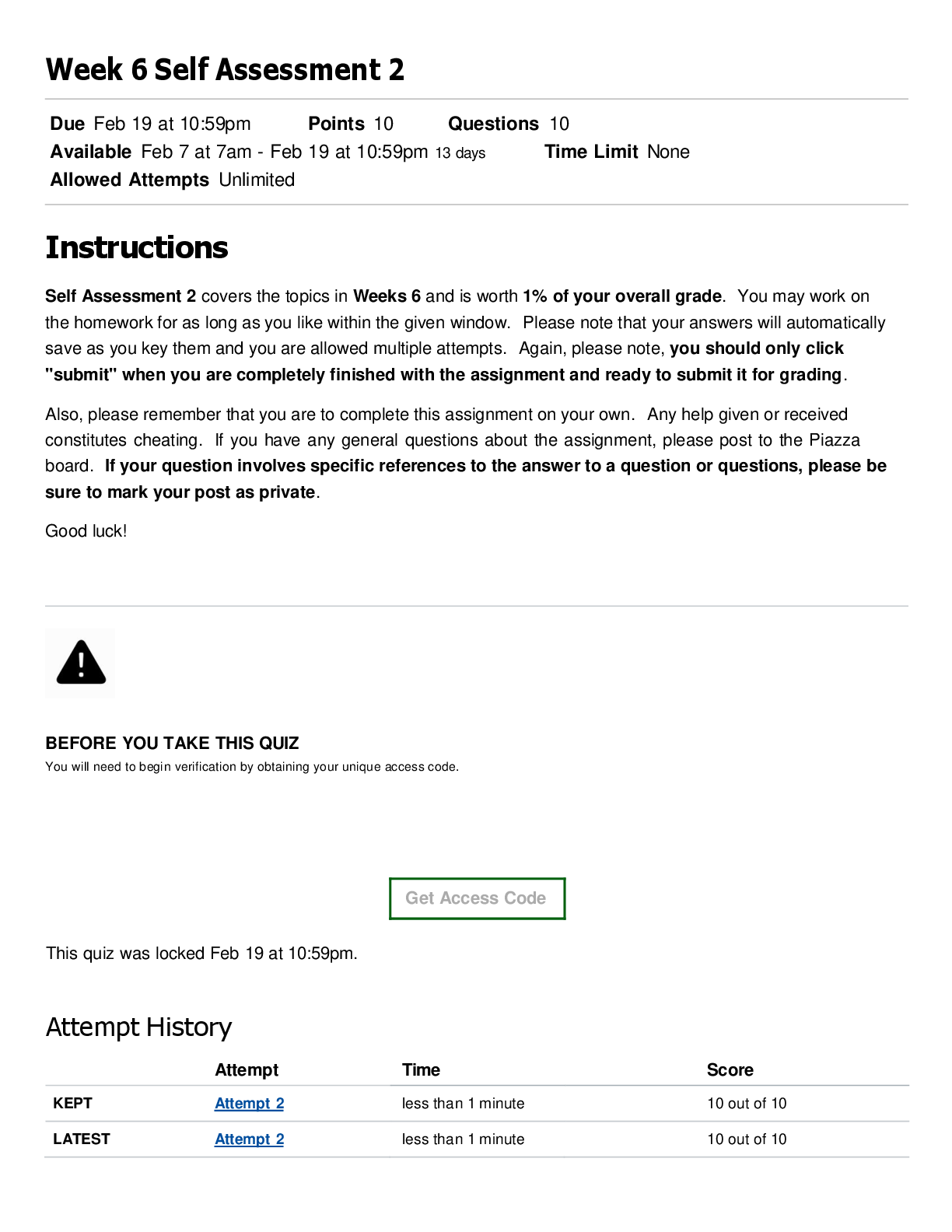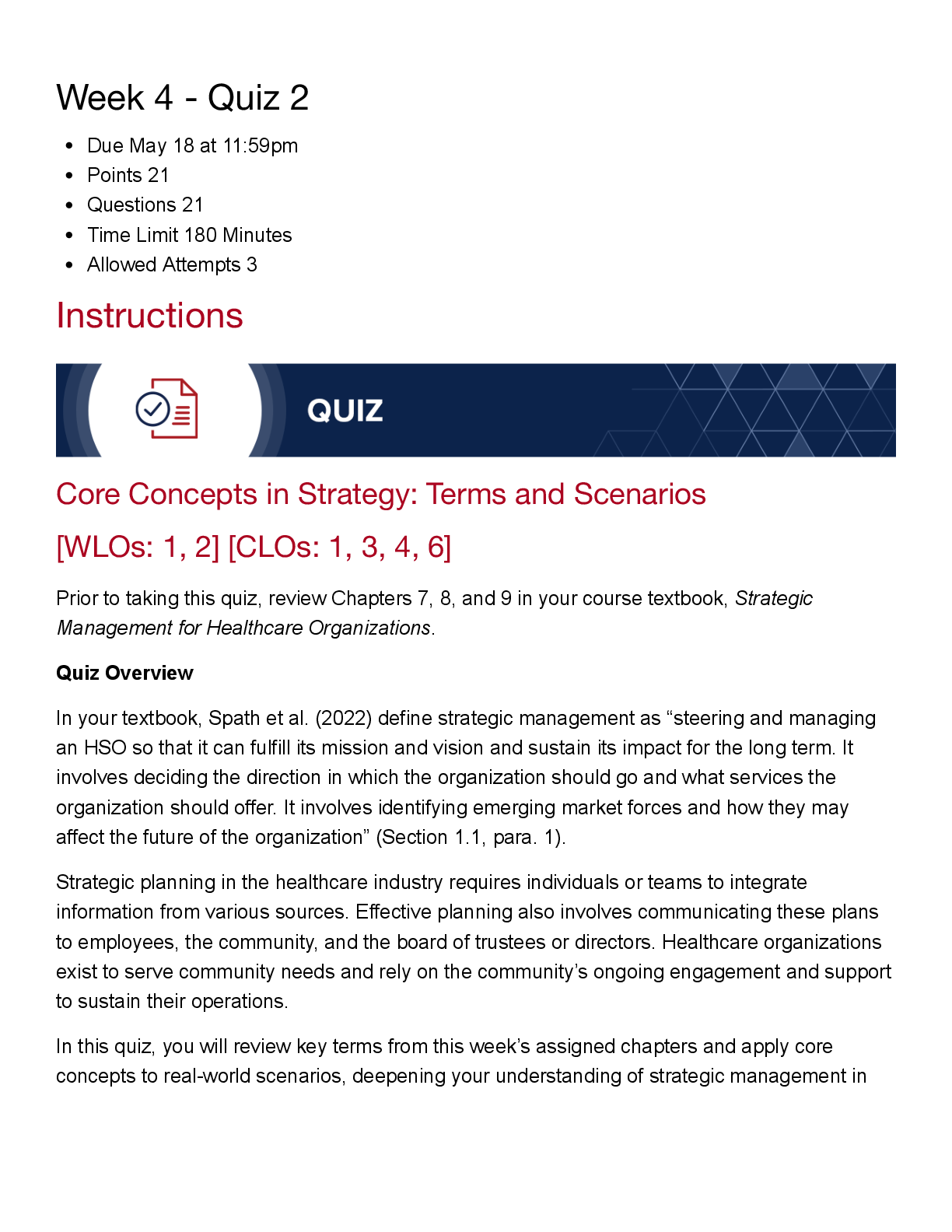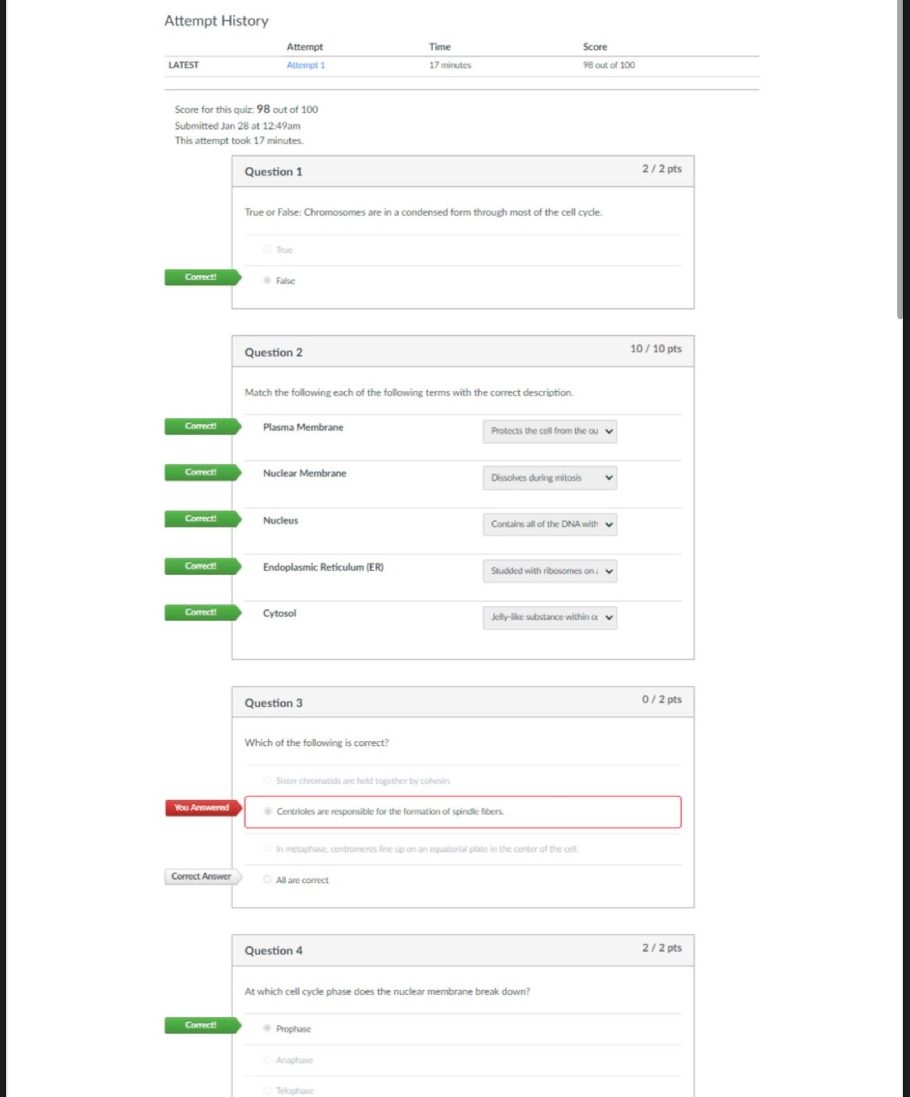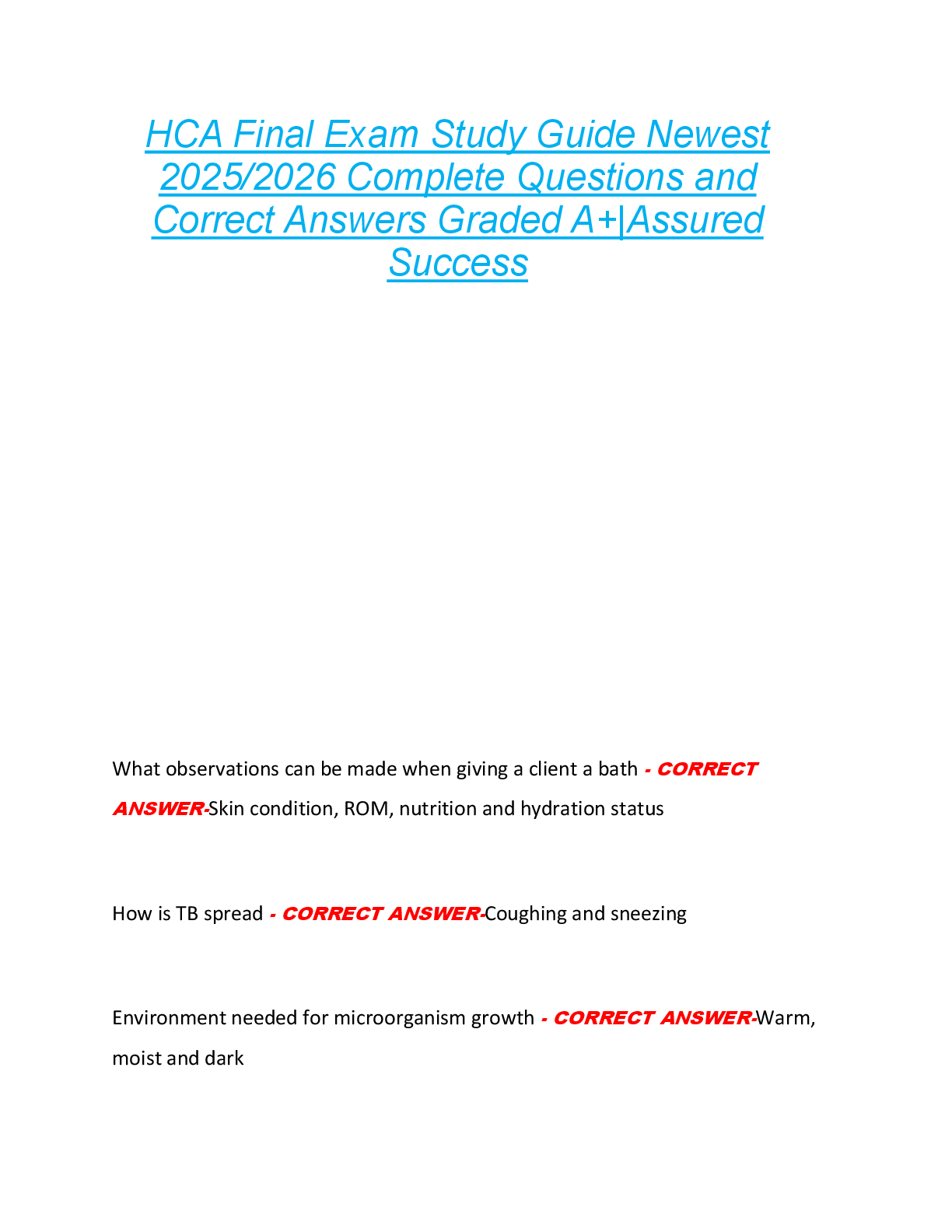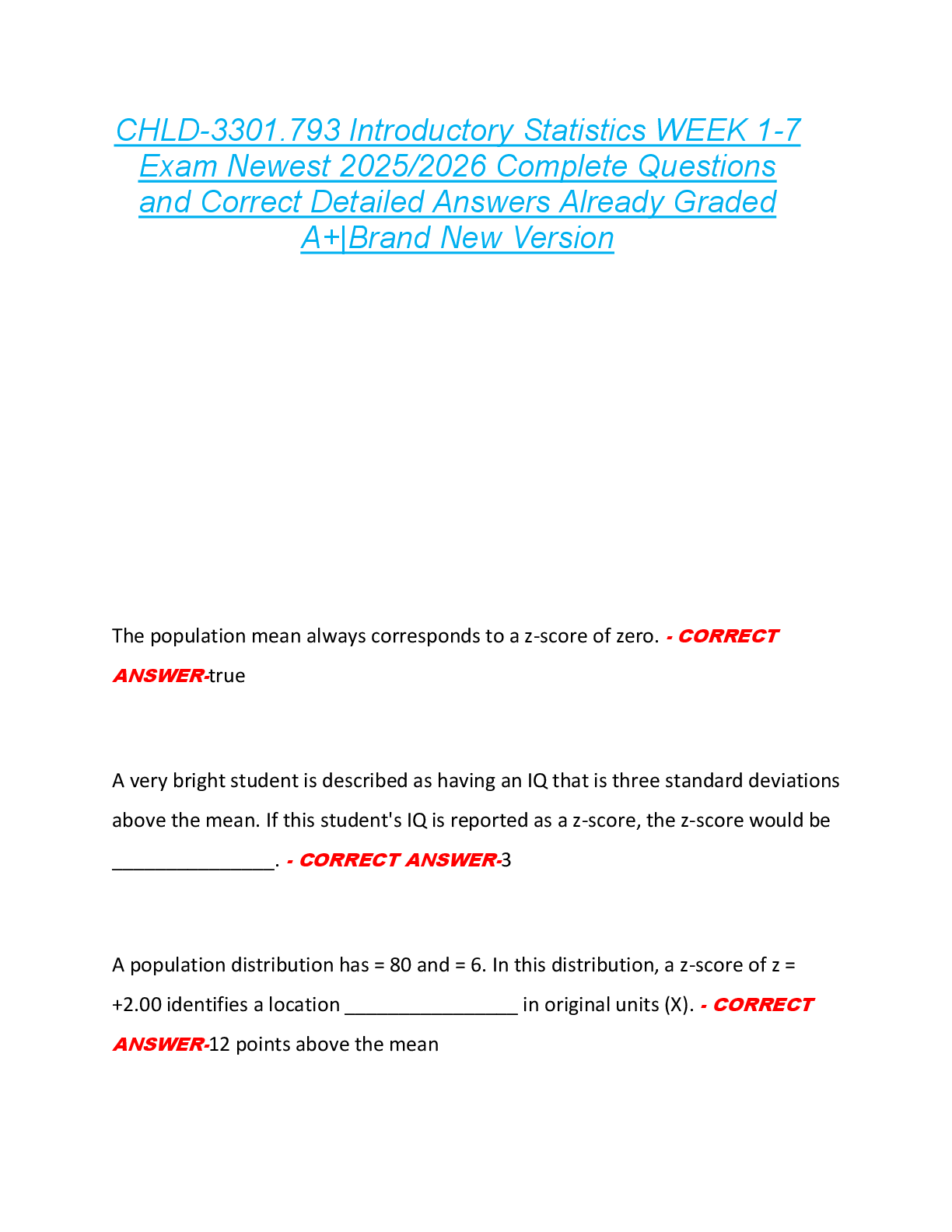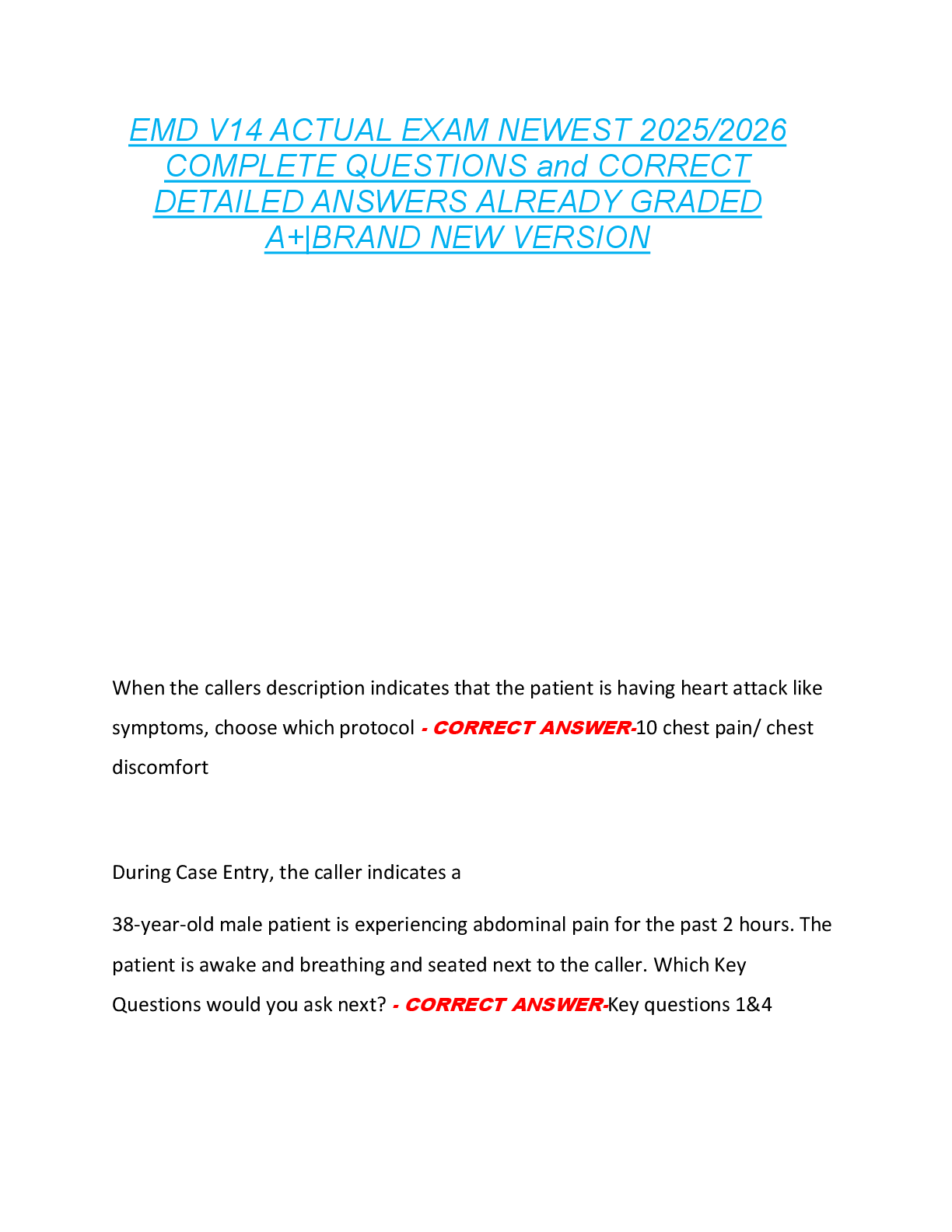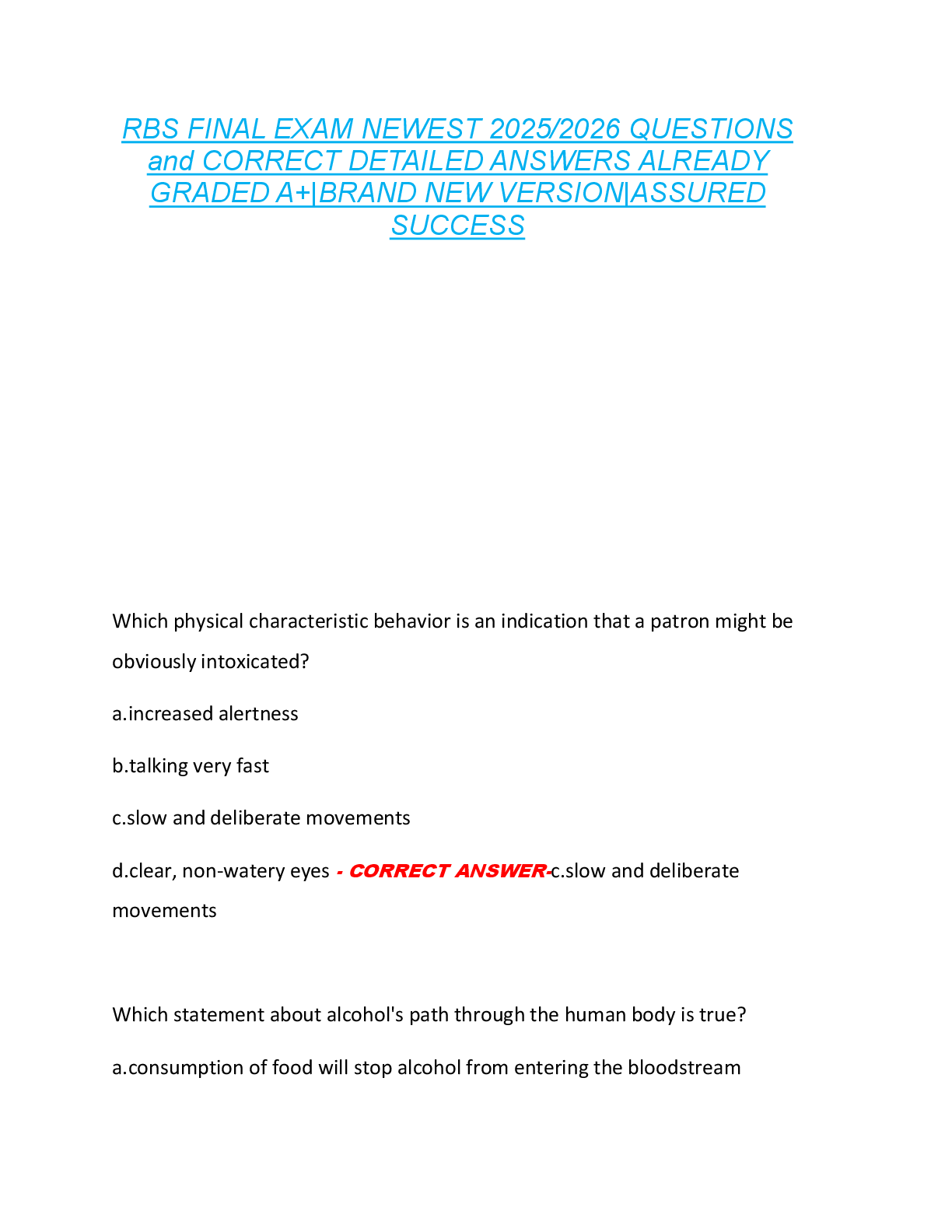Astronomy Midterm 4 Exam - Complete Solutions (Answered)
Document Content and Description Below
Astronomy Midterm 4 Exam - Complete Solutions (Answered) Which of the following does not have a major effect in shaping planetary surfaces? a) impact cratering b) volcanism c) tetonics d) erosion e)
...
magnetism How large is an impact crater compared to the size of the impactor? a) the same size b) 10-20 percent larger c) 10 times larger d) 100 times larger e) 1,000 times larger The relatively few craters that we see within the lunar maria a) were formed by impacts that occurred after those that formed most of the craters in the lunar highlands b) were formed by impacts that occurred after those that formed most of the craters in the lunar highlands. c) were created by the same large impactor that led to the formation of the maria d) are volcanic in origin, rather from the impacts e) are sinkholes that formed when sections of the maria collapsed When we see a region of a planet that is not as heavily cratered as other regions, we conclude that a) there is little volcanic activity to create craters b) the planet is rotating very slowly and only one side was bit by impactors c) the planet formed after the age of bombardment and missed out on getting hit by leftover planetesimals d) the surface in the region is older than the surface in more heavily cratered regions e) the surface in the region is younger than the surface in more heavily cratered regions Volcanism is more likely on a planet that a) is closer to the sun b) is stuck often by meteors and solar system debris c) has high internal temperatures d) doesn't have an atmosphere or oceans. Shallow-sloped shield volcanoes are made from lava that a) is a runny as liquid water b) has a medium viscosity c) has a high viscosity d) can have any viscosity Step-sided stratovolcanoes are made from lava that a) is as runny as liquid water b) has a medium viscosity c) has a high viscosity d) can have any viscosity What type of stresses broke Earth's lithospehre into plates? a) impacts of asteroids and planetesimals b) Internal temperature changes that caused the crust to expend and stretch c) the circulation of convection cells in the mantle, which dragged against the lithosphere d) cooling and contracting of the planet's interior, which caused the mantle and lithosphere to be compressed e) volcanism, which produced heavy volcanoes that bent and cracked the lithosphere Which of the following describes tetonics? a) the excavation of bowl-shaped depressions by asteroids or comets striking a planet's surface b) the eruption of molten rock from a planet's interior to its surface c) the disruption of a planet's surface by internal stress d) the wearing down or building up of geological features by wind, water, ice, and other phenomena of planetary weather. Which of the following describes erosion? a) the excavation of bowl-shaped depression by asteroids or comets striking a planet's surface b) the eruption of molten rock from a planet's interior to its surface c) the disruption of a planet's surface by internal stresses d) the wearing down or building up of geological features by wind, water, ice, and other phenomena of planetary weather Which of the following describe volcanism? a) the excavation of bowl-shaped depression by asteroids or comets striking a planet's surface b) the eruption of molten rock from a planet's interior to its surface c) the disruption of a planet's surface by internal stress d) the wearing down or building up of geological features by wind, water, ice, and other phenomena of planetary weather Which of the following describes impact cratering? a) the excavation of bowl-shaped depressions by asteroids or comets striking a planet's surface b) the eruption of molten rock from a planet's interior to its surface. c) the disruption of a planet's surface by internal stresses d) the wearing down or building up of geological features by wind, water, icec, and other phenomena of planetary weather. A planet is most likely to have tetonic activity if it has a) a low surface gravity b) high surface gravity c) low internal temperature d) high internal temperature e) a dense atmosphere What kind of surface features may result from tetonics? a) mountains b) valleys c) volcanoes d) cliffs e) all of the above What is basalt? a) any substance that evaporates easily and is gas, liquid, or ice on Earth b) a type of rock that makes relatively low-viscosity lava c) a type of metal that tends to create stratovolcanoes when eruption occur d) a type of mineral that is the main ingredient of sea salt e) another name for lava How did the lunar maria form? a) large impacts fractured the Moon's lithosphere, allowing lava to fill the impact basins b) The early bombardment created heat that melted the lunar surface in the regions of the maria. c) Volatiles escaping from the Moon's interior heated and eroded the surface in the regions of the maria. d) The giant impact that created the Moon left smooth areas that we call the maria. e) The maria are the result of gradual erosion by micrometeorites striking the Moon. What process has shaped Earth's surface more than any other a) impact cratering b) volcanism c) plate tectonics d) erosion e) acid rain Why are there few large craters on the seafloor than on the continents? a) the seafloor crust is younger than the continental crust b) the oceans slow large impactors and prevent them from making craters. c) the oceans erode away craters faster than erosion processes on land d) large impactors primarily strike land masses e) large impactors aim for life-forms such as dinosaurs How does the seafloor crust differ from continental crust? a) seafloor crust is thicker, older, and higher in density b) seafloor crust is thinner, younger, and higher in density c) seafloor crust in thinner, older, and lower in density d) seafloor crust is thicker, older, and lower in density e) seafloor crust is thicker, younger, and lower in density Why is continental crust lower in density than seafloor crust? a) continental crust is made from remelted seafloor crust and therefore only the lower-density material rises from it. b) continental crust is made from volcanic rock called basalt, which is lower in density than what the seafloor crust is made from c) Continental crust is made of rock, while seafloor crust has more metals. d) Seafloor crust is more compact due to the weight of the oceans, but it is made of the same material as the continental crust. e) Continental crust is actually denser than seafloor crust. Which of the following is not evidence for plate tectonics on Earth? a) some continental boundaries fit together like pieces of a jigsaw puzzle b) similar rocks and fossils are found in different continents c) high ocean ridges between the continents d) existence of volcanoes e) earthquakes. How fast do plates move on Earth? a) a few centimeters per year b) a few millimeters per century c) a few kilometers per century d) quite fast, but only during earthquakes e) about 1 mile per hour How long, approximately, do geologists estimate it takes for the entire seafloor to be replaced due to plate tectonics? a) 2 million years b) 20 million years c) 200 million years d) 2 billion years e) longer than the age of the solar system What drives the motion of the tectonics plates on Earth? a) convection cells in the mantle b) lava flows in trenches along the sea floor c) the coriolis force d) earth's magnetic field e) tidal forces Ridges in the middle of the ocean are places where a) one plate slides under another, returning older crust to the mantle b) hot mantle material rises upward, creating volcanic islands c) hot mantle material rises upward and spread sideways, pushing the plates apart d) plates push together, creating ocean mountain chains e) plates slip sideways relative to one another Deep trenches in the ocean mark places where a) one plate slides under another, returning older crust to the mantle b) plates pull apart, leaving great rifts in the crust c) hot mantle material rises upward and spreads sideways, pushing the plates apart d) plates push together, creating ocean mountain chains e) plates slip sideways relative to one another. Some of the oldest continental crust on Earth lies in a) Hawaii b) California c) the great plains d) the deep south e) Northeastern Canada Which of the following regions was the result of plumes of hot mantle rising in a hot spot within a plate? a) Alaska's Aleutian Island b) Japan and Philippines c) the islands of Hawaii d) the volcano Mount St. Helens e) all of the above The geysers and hot springs of Yellowstone National Park result from a) a thin continental crust separating and creating a rift valley b) plumes of hot mantle rising in a hot spot within a plate c) plates that have slipped sideways relative to each other, creating a fault d) a plate that has run up against an existing continental plate e) a fault The strength of a rock depends on its composition, its temperature, and the surrounding pressure a) true b) false Higher temperatures make rocks weaker a) true b) false Very high pressures, like those found deep within planetary interiors, can compress rocks so much that they stay solid even when temperatures are high enough to melt them under ordinary conditions. a) true b) false Smaller worlds generally have thinner lithospheres a) true b) false Earth is the only planet in the solar system known to have plate tectonics. a) true b) false The magnetic and rotational north poles on Earth are the same. a) true b) false Which of the following correctly describes the meaning of albedo? a) the lower the albedo, the more light the surface reflects, and the less it absorbs b) the higher the albedo, the more light the surface reflects, and less it absorbs c) the higher the albedo. the more light the surface absorbs. d) The higher the albedo, the more light the surface emits. e) The higher the albedo, the more light the atmosphere absorbs. Earth's stratosphere is heated primarily by which process? a) convection from the Earth's surface b) absorption of infrared radiation by greenhouse gases. c) absorption of visible light by ozone d) absorption of ultraviolet radiation by ozone e) atoms and molecules absorb infrared sunlight Suppose Earth's atmosphere has no greenhouse gases. Then Earth's average surface temperature would be a) 250 K, which is well below freezing b) 273 K, or about the freezing point for water c) 283 K, or about 5 K cooler than it is now d) 288 K, or about the same as now e) 293 K, or about 5 K warmer than it is now What are greenhouse gases? a) gases that absorb visible light b) gases that absorb ultraviolet light c) gases that absorb infrared light d) gases that transmit visible light e) gases that transmit infrared light Which of the following gases absorb ultraviolet light the best? a) carbon dioxide b) nitrogen c) oxygen d) hydrogen e) ozone X rays from Sun's corona a) are absorbed in Earth's troposphere b) are absorbed in Earth's thermosphere c) cause meteor showers d) break apart ozone in the stratosphere e) generally reach Earth's surface and fry us How does the greenhouse effect work? a) greenhouse gas transmit visible light, allowing it to heat the surface, but then absorb infrared light from Earth, trapping the heat near the surface. b) The higher pressure of the thick atmosphere at lower altitudes traps heat in more effectively. c) Ozone transmits visible light, allowing it to heat the surface, but then absorbs most of the infrared heat, trapping the heat near the surface. d) Greenhouse gases absorb X rays and ultraviolet light from the Sun, which then heat the atmosphere and the surface. e) Greenhouse gases absorb infrared light from the Sun, which then heats the atmosphere and the surface. The proper order of the layers of a generic atmosphere from lowest altitude to highest is a) troposphere, stratosphere, exosphere, thermosphere. b) troposphere, stratosphere, thermosphere, exosphere. c) stratosphere, troposphere, exosphere, thermosphere. d) stratosphere, troposphere, thermosphere, exosphere. e) none of the above What is the exosphere? a) the lowest layer in the atmosphere b) the part of the atmosphere that absorbs optical light c) the part of the atmosphere that absorbs ultraviolet d) the part of the atmosphere that absorbs X-rays e) the highest layer in the atmosphere What is the thermosphere? a) the lowest layer in the atmosphere b) the part of the atmosphere that absorbs optical light c) the part of the atmosphere that absorbs ultraviolet d) the part of the atmosphere that absorbs x-rays e) the highest level in the atmosphere What is a stratosphere? a) the lowest layer in the atmosphere b) the part of the atmosphere that absorbs optical light c) the part of the atmosphere that absorbs ultraviolet d) the part of the atmosphere that absorbs x-rays e) the highest level in the atmosphere What is the troposphere? a) the lowest layer in the atmosphere b) the part of the atmosphere that absorbs optical light c) the part of the atmosphere that absorbs ultraviolet d) the part of the atmosphere that absorbs x-rays e) the highest level in the atmosphere The thermosphere is warm because it a) absorbs x-rays b) absorbs infrared light c) absorb visible light d) contains greenhouse gases e) absorbs ultraviolet light Which of the following worlds has the most substantial atmosphere? a) Mercury b) Venus c) the Moon d) Mars e) Earth Which of the following planets has the least substantial atmosphere? a) Venus b) Earth c) Mars d) Neptune e) Mercury Which of the following worlds has the greatest difference in temperature between its "no atmosphere" temperature and its actual temperature?
a) Mercury b) Venus c) Earth d) the Moon e) Mars *Why does Venus have such a great difference in temperature between its "no atmosphere" temperature and its actual temperature?* a) It has a slow rotation. b) It is so close to the Sun. c) It has a large amount of greenhouse gases in its atmosphere. d) It has a high level of volcanic activity. e) It has no cooling effects from oceans. Ultraviolet light is absorbed in the a) exosphere b) thermosphere c) stratosphere d) troposphere e) none of the above The ionosphere is a layer of ionized gas that is a) above the exosphere b) between the thermosphere and exosphere c) within the thermosphere d) within the stratosphere e) within the troposphere The sky is blue because a) molecules scatter blue light more effectively than red light b) molecules scatter red light more effectively than blue light c) the sun mainly emits blue light d) the atmosphere transmit mostly blue light e) the atmosphere absorbs mostly blue light. Sunsets are red because a) the sun emits more red light when its setting b) sunlight must pass through more atmosphere then, and the atmosphere scatters even more light at bluer wavelengths, transmitting mostly red light.
[Show More]
Last updated: 1 year ago
Preview 5 out of 37 pages

